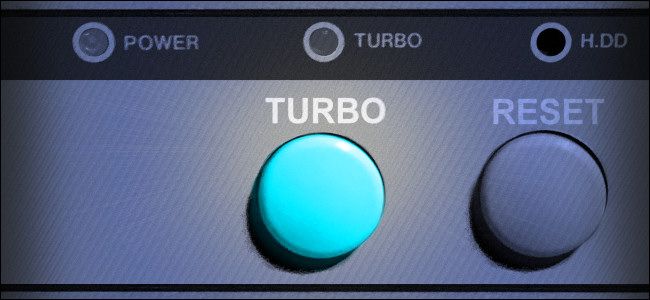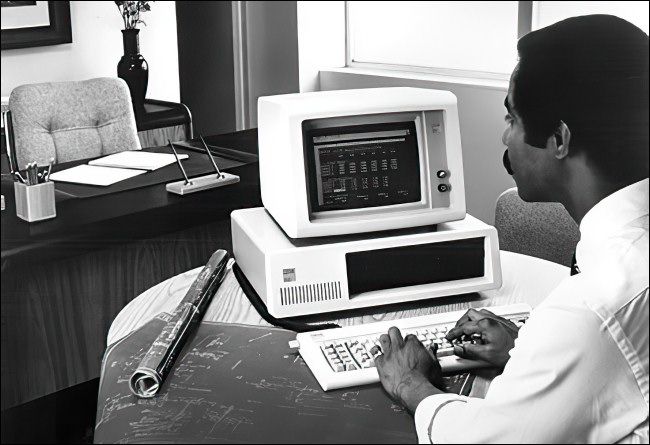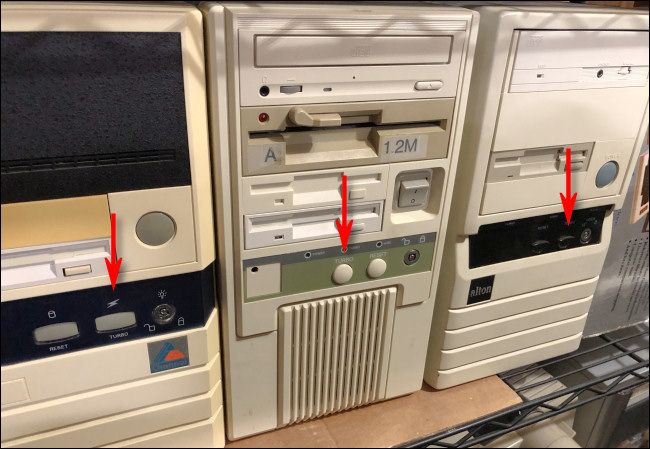Quick Links
In the 1980s and '90s, many IBM PC clones included a button on the case labeled "Turbo" that actually slowed down your PC when you pressed it. We explore why it was necessary, what it did, and who put it there in the first place.
Attack of the Speedy Clones
The first IBM Personal Computer, released in August 1981, included an 8088 CPU that ran at 4.77 MHz. Competitors, like Compaq, soon reverse-engineered the machine, licensed Microsoft's MS-DOS operating system, and created their own IBM PC-compatible computers.
These clone machines often added features that were missing from IBM's PC series at a much lower price. Some included integrated peripheral ports, more RAM, and real-time clocks, while retaining software compatibility. Some of the early clone manufacturers took things even further and produced much faster machines. For example, several models used an 8 MHz Intel 8086 chip that was roughly two to three times as fast as the original IBM PC's CPU.
New PCs Were Too Fast for Existing Applications
This speed increase introduced a problem. Most application developers in the early '80s didn't anticipate that the IBM PC would become a backward-compatible platform, or that its performance would skyrocket. As a result, most software applications and games created for the IBM PC were tuned specifically to the 5150's 4.77 MHz clock speed. If someone attempted to run them at faster speeds (like 8 MHz or beyond), some of these early programs became unstable. Many games became unplayably fast.
Early IBM PC CPU accelerator cards solved this problem by including a physical switch on the back, allowing the machine to switch between the accelerator's maximum speed and a 4.77 MHz compatibility mode. On some PC clones, you could even use BIOS-level keyboard shortcuts, such as Ctrl+Alt+Plus or Ctrl+Alt+Backslash, to toggle between CPU speed modes.
These weren't yet referred to as "turbo" modes, though; but that marketing innovation was just around the corner.
Enter the Eagle PC Turbo (and the Turbo Button)
Around July 1984, in Los Gatos, California, a PC clone manufacturer called Eagle Computer introduced a new product line called the Eagle PC Turbo. Each model included a speedy 8 MHz 8086 CPU, and a new feature: a Turbo button on the front panel. When pressed, it toggled the computer between 8 and 4.77 MHz clock speeds.
The media noted how novel Eagle's innovation was at the time. In its December 11, 1984 issue, PC Magazine gushed over the Eagle PC Turbo's speed:
"In fact, it is so fast that Eagle had to include a front-panel push-button to slow down operations by inserting extra wait states when required for PC-compatibility."
That article also features the only known photo of the Eagle PC Turbo and its seminal Turbo button available on the web.
PC Tech Journal also noted the arrival of the Eagle PC Turbo line in its July 1984 issue:
"The 8086-based machine has a 'Turbo' button on the front panel. Press it and the machine switches from the PC/XT compatible clock speed of 4.77 Mhz to 8 Mhz."
It's possible that another manufacturer used the term "Turbo button" prior to Eagle computer. However, after an exhaustive search through early 1980's computer periodicals, we think it unlikely.
The word "turbo" is an abbreviation of "turbocharger," a device that makes internal combustion engines run faster. In the '80s, it was common for commercial marketing departments to apply the word "turbo" to products to denote extra speed or power. No manufacturer would ever include a large button labeled "Slow" on the front of its speedy new PC, so "Turbo" was a clever choice on Eagle's part.
A few years after the introduction of the Eagle Turbo PC (when accelerated PC clones became inexpensive enough to be mass-market items), "turbo" suddenly became the generic industry term for this CPU slowdown feature. This is likely because other PC manufacturers copied it, and put it in off-brand commodity PC cases and motherboards.
By 1988, Turbo buttons were everywhere.
Turbo Buttons Exploded in Popularity
In the early-to-mid 1990s, the average CPU clock speeds of IBM PC compatibles jumped into the stratosphere. They moved from about 16 MHz to around 100, with stops at 20, 33, 40, and 66 MHz along the way. This made Turbo buttons absolutely essential to play early PC games, many of which were still less than a decade old at the time.
Some PC cases even included a two-digit, segmented LED display that switched between the turbo and non-turbo numeric clock speeds whenever you pushed the Turbo button. Interestingly, this feature was often configured on the LED module. So, these could be configured to show any number, proving this to be yet another marketing gimmick.
Modern Software Left the Turbo Button Behind
At some point, most application developers began to write new software with CPU speed increases in mind. These programs would measure the system's clock speed and introduce a delay, if necessary, to keep the program running at the designed pace. This worked even if you ran the program on a much faster CPU introduced after that particular software.
As those programs became mainstream, and legacy 1980s software was less commonly used, fewer and fewer people used Turbo buttons.
Around the Pentium era in the mid-to-late 1990s, many generic PCs and build-your-own PC cases stopped including Turbo buttons. In the low-margin world of commodity PCs at that time, any extraneous features usually bit the dust fairly quickly to save costs.
By 2000, the Turbo button had basically become extinct on new machines. Around that time, if people wanted to slow down DOS programs, they often used software applications like Mo'Slo or CPUKILLER instead.
The Age of Turbo had ended, but consumer-level CPU overclocking was just around the corner. It proved once and for all that a true "turbo mode" that actually sped up machines, instead of slowing them down was possible after all.




